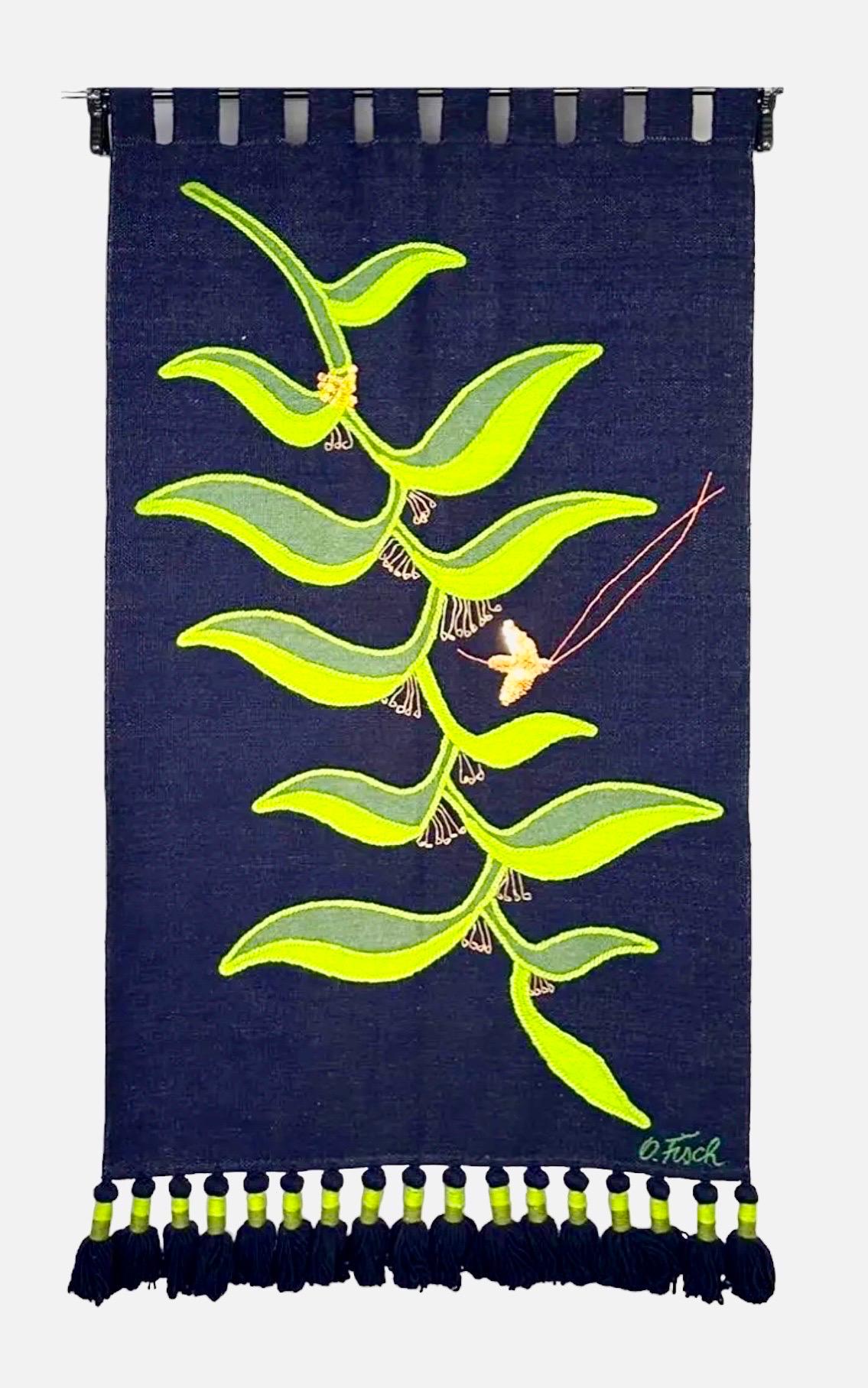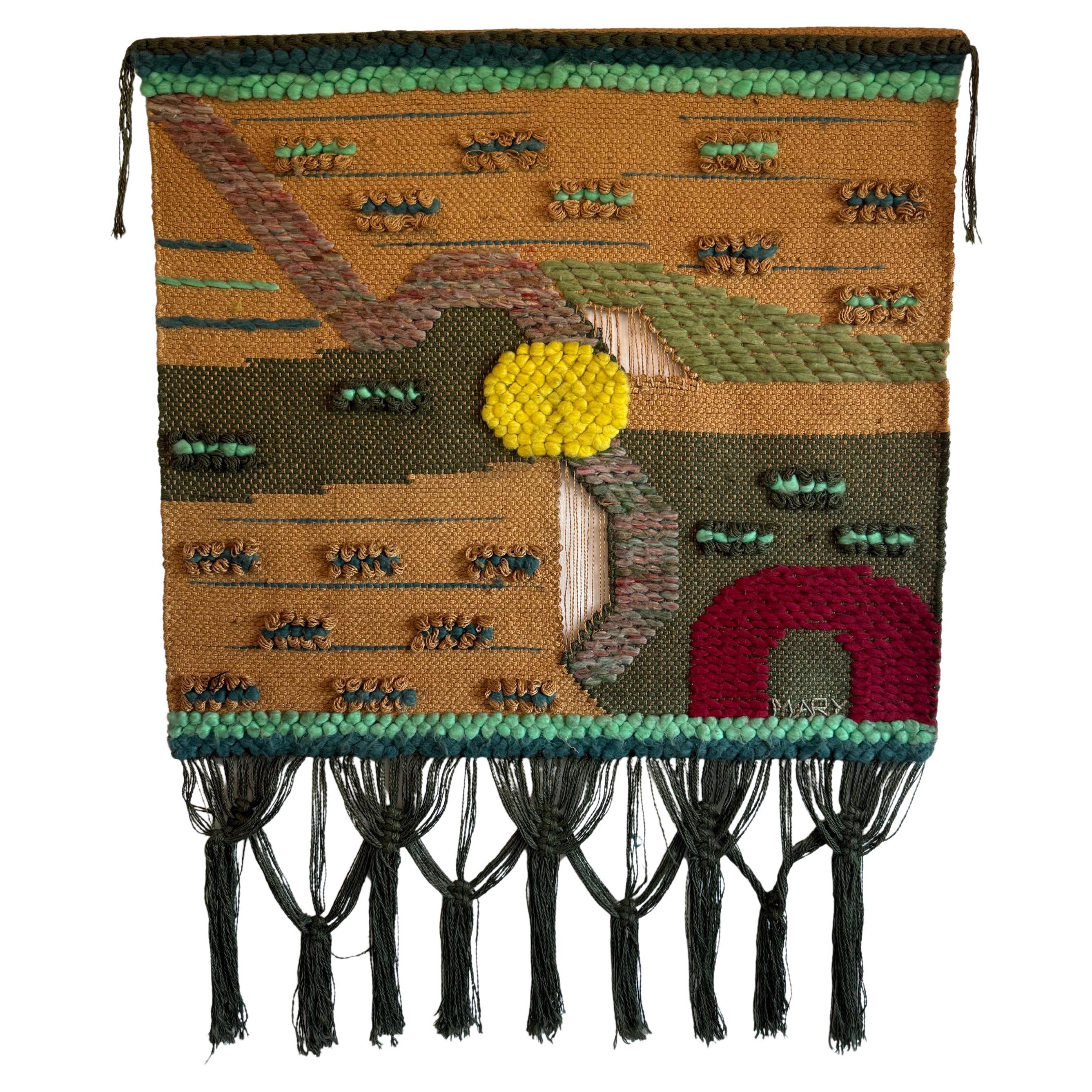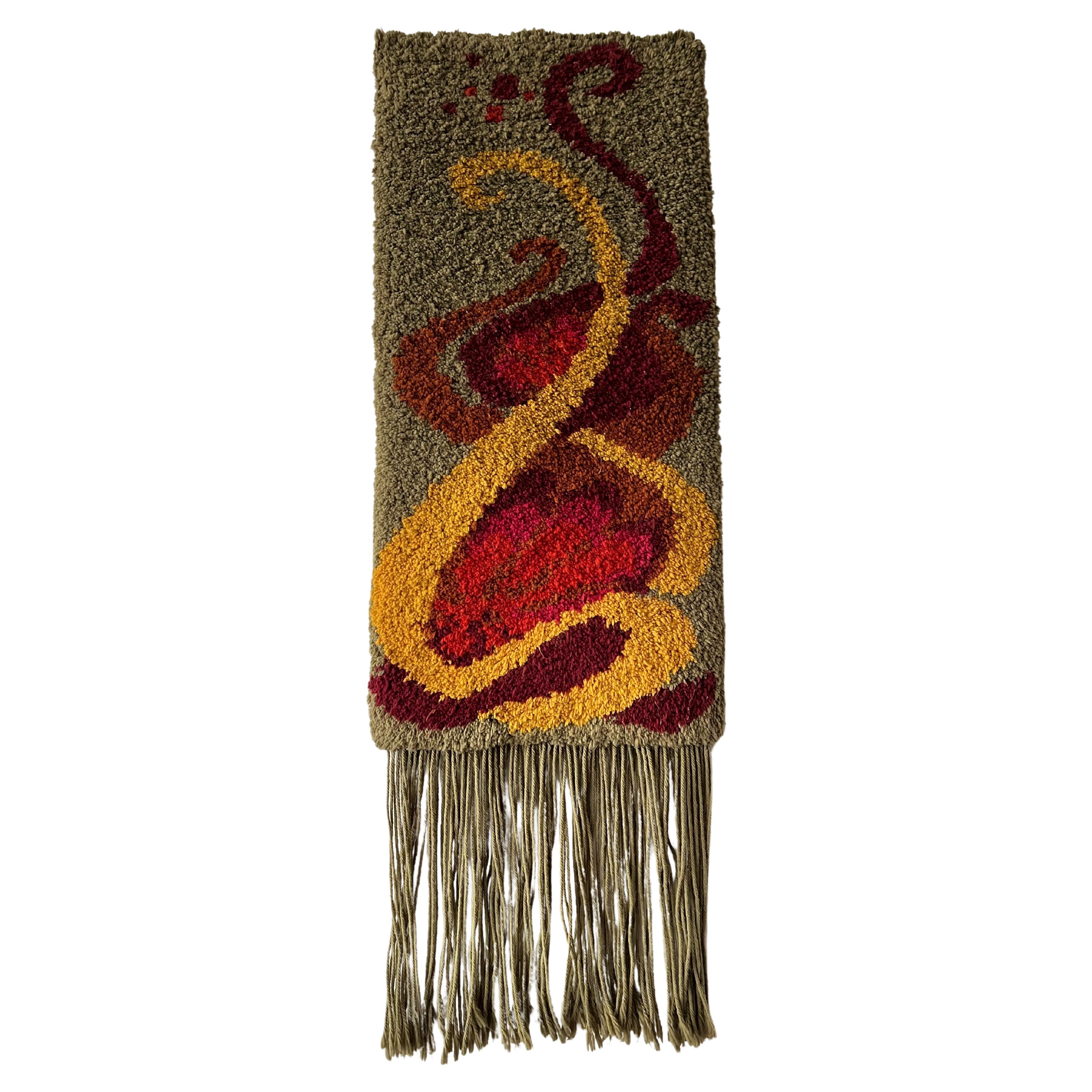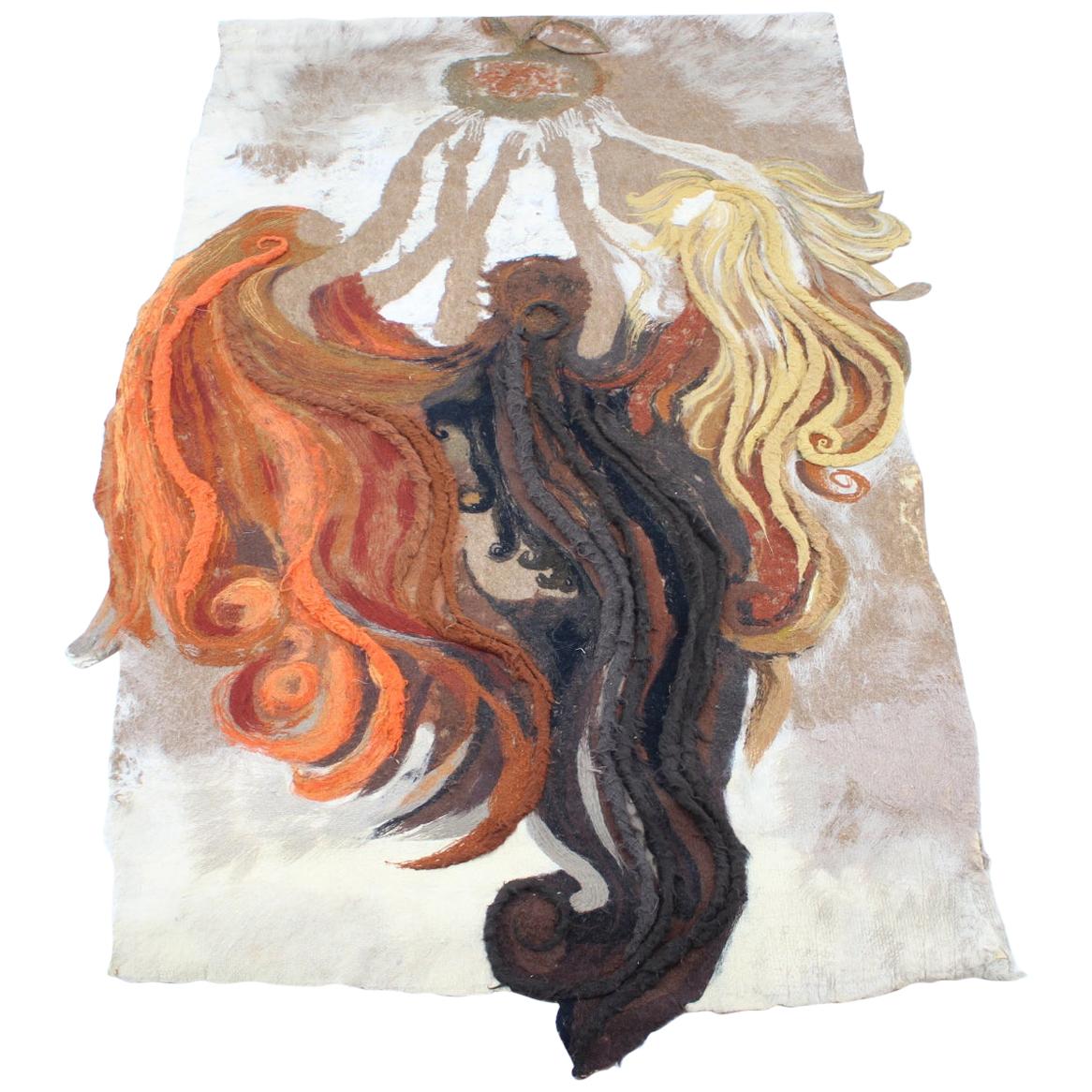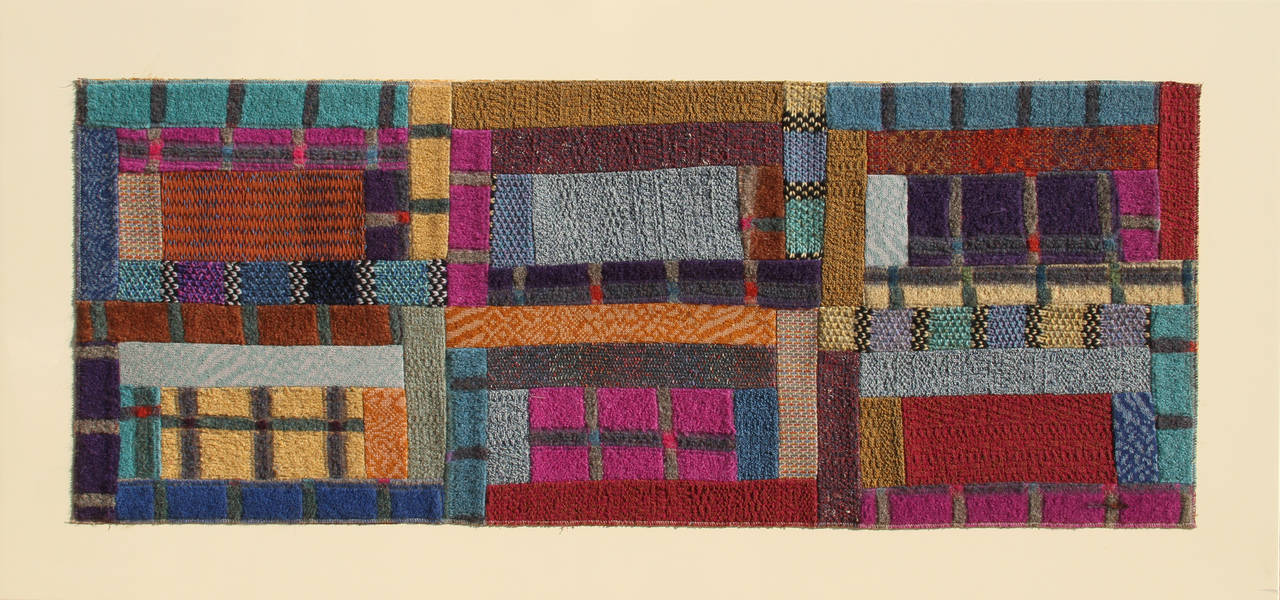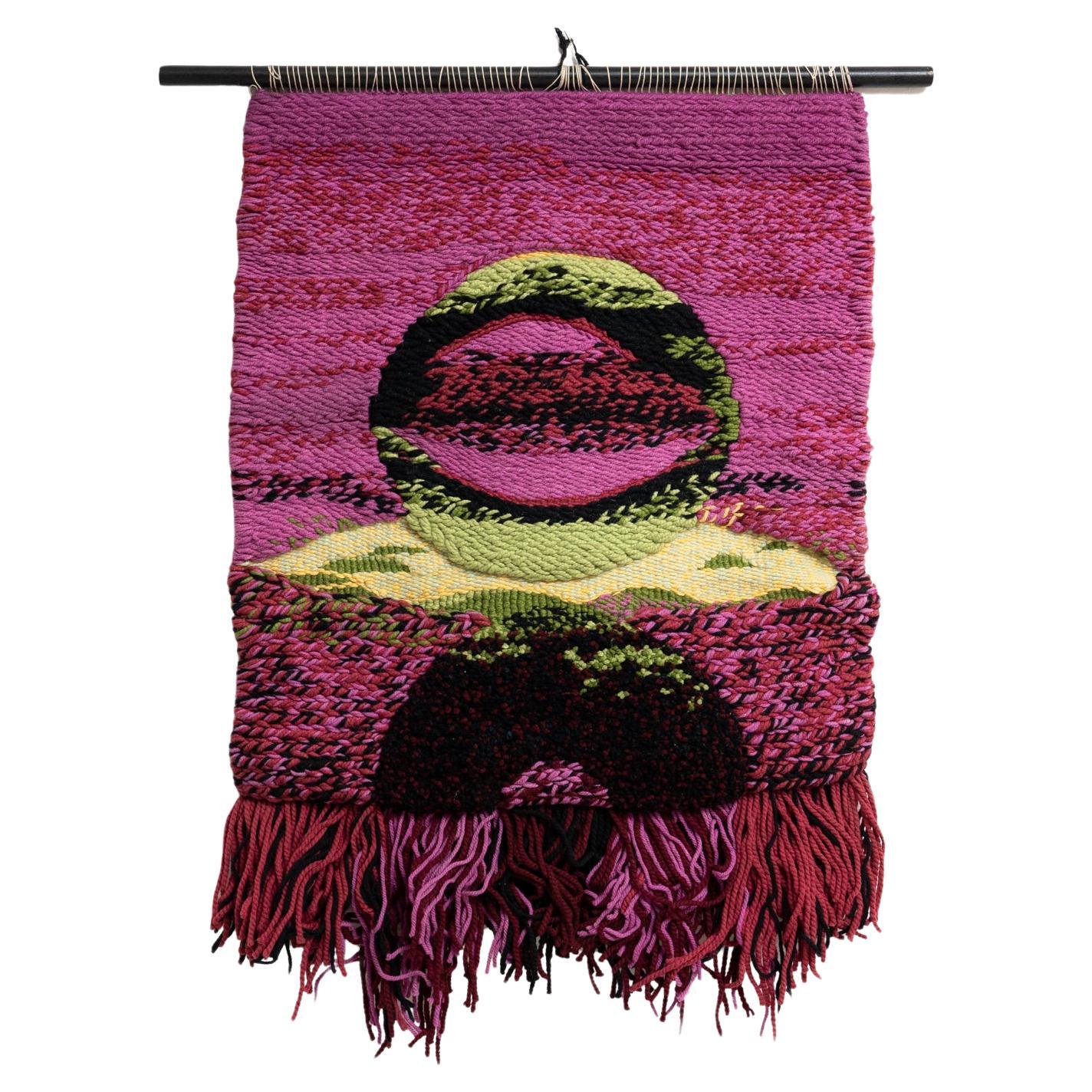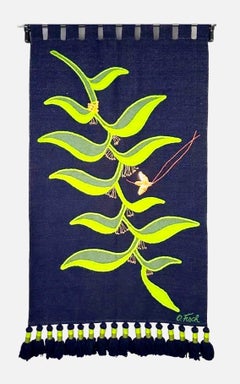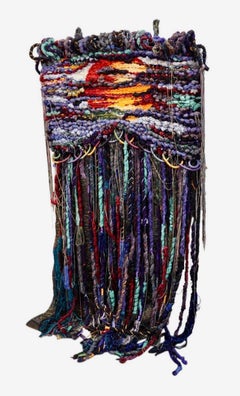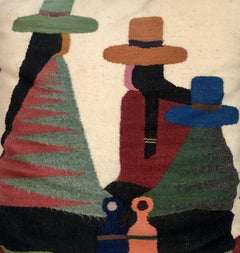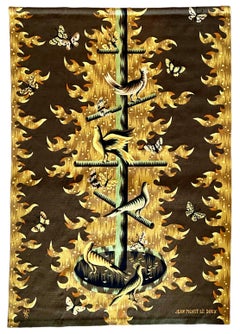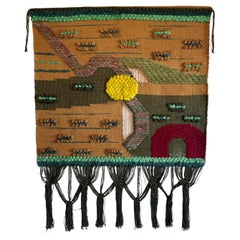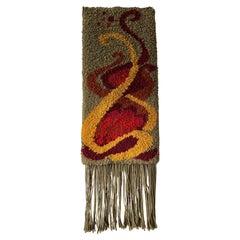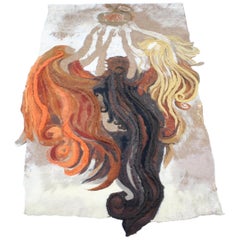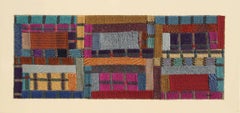Items Similar to Hand Woven Wool Tapestry Feminist Textile Art Wall Hanging Judy Chicago Homage
Want more images or videos?
Request additional images or videos from the seller
1 of 12
UnknownHand Woven Wool Tapestry Feminist Textile Art Wall Hanging Judy Chicago Homagec.1970's
c.1970's
$6,500
£4,908.54
€5,619.83
CA$9,179.70
A$10,022.03
CHF 5,254.14
MX$121,721.46
NOK 65,615.68
SEK 61,958.70
DKK 41,946.02
About the Item
This measures 41 inches in width and 75 inches in height to end of tassels without the tassels it is 57 inches in length
This is a wool handmade weaving tapestry, The imagery seems inspired by Judy Chicago or a related artist from the Feminism movement. It might also be related to Arik Brauer or Austrian Fantastic Realism or Magic Realism.
It appears to be hand signed with initials or a monogram lower right.
It does not have label. It is a flat weave but not as flat as a French Pinton Aubusson tapestry it is a bit thicker, It does not have pile like a rug. it has a tassel that hangs from the bottom edge and a fringe at the sides.
There has a been a resurgence in both textile fabric and fiber art, artists such as Sheila Hicks, Harlem born Faith Ringgold, Polish artist Magdalena Abakanowicz and Colombian artist Olga de Amaral as well as Feminist artists such Nancy Spero, Louise Bourgeois, Kiki Smith, Joan Snyder, Joyce Kozloff, Audrey Flack and Judy Chicago,
About the Seller
4.9
Platinum Seller
Premium sellers with a 4.7+ rating and 24-hour response times
Established in 1995
1stDibs seller since 2014
1,810 sales on 1stDibs
Typical response time: 1 hour
- ShippingRetrieving quote...Shipping from: Miami, FL
- Return Policy
Authenticity Guarantee
In the unlikely event there’s an issue with an item’s authenticity, contact us within 1 year for a full refund. DetailsMoney-Back Guarantee
If your item is not as described, is damaged in transit, or does not arrive, contact us within 7 days for a full refund. Details24-Hour Cancellation
You have a 24-hour grace period in which to reconsider your purchase, with no questions asked.Vetted Professional Sellers
Our world-class sellers must adhere to strict standards for service and quality, maintaining the integrity of our listings.Price-Match Guarantee
If you find that a seller listed the same item for a lower price elsewhere, we’ll match it.Trusted Global Delivery
Our best-in-class carrier network provides specialized shipping options worldwide, including custom delivery.More From This Seller
View AllVintage Handwoven Tapestry Wool Folk Art Rug Weaving Wall Hanging Olga Fisch
By Olga Fisch
Located in Surfside, FL
Olga Fisch ( American 1901-1990)
Hummingbird and Pendant Flower, hand woven and stitched wool and sequins, signed lower right.
Dimensions: 58 x 32 in.
Olga Fisch was born in Hungary, studied in Germany and lived in Morocco and Ethiopia before receiving asylum as a Jewish refugee in Ecuador in 1939. For her Indian-inspired designs, Mrs. Fisch uses natural black and white sheep...
Category
20th Century Folk Art More Art
Materials
Wool
Large Handmade Tapestry Textile Wall Hanging Wool Mixed Media Marlene Richard
Located in Surfside, FL
Eclectic, mixed media wall hanging textile tapestry by Marlene (Marlen) Richard featuring abstract embroidery atop free hanging locks of fabric over a black background embellished with gilt fabric accents. Hand made and hand embroidered. This had a paper artists label but it has since become detached. Overall image resembles a colorful pop art sunset over ocean waters. Hanging cords in various fabrics, colors and textures. Her work bears the influence of Sheila Hicks and bears similarities to Latin American, Colombian textile artists Olga de Amaral and Stella Bernal. Hand made, hand woven felt and wool spectacular textile wall hanging fabric sculpture by Miami woman artist Marlene Richard. It consists of long hanging pods...
Category
20th Century Contemporary Abstract Sculptures
Materials
Metal
Vintage Handwoven Tapestry Wool Folk Art Rug Weaving Pillow or Wall Hanging
By Olga Fisch
Located in Surfside, FL
Olga Fisch was born in Hungary, studied in Germany and lived in Morocco and Ethiopia before receiving asylum as a Jewish refugee in Ecuador in 1939. For her Indian-inspired designs, Mrs. Fisch uses natural black and white sheep...
Category
1950s Folk Art More Art
Materials
Wool
Art Deco French Modernist Handmade Aubusson Gobelin Tapestry Jean Picart Le Doux
By Jean Picart Le Doux
Located in Surfside, FL
Jean Picart Le Doux, French (1902 - 1982)
"Au Rendez Vous Des Oiseaux"
Larger handmade wool Aubusson tapisserie
Produced by Maison M. Berthaut Aubusson Atelier, France. Signed Lower left corner woven with firm's monogram and lower right with artists full name.
Bears stitched label attached en verso.
Original documents included with the lot.
Measures 71-1/2" x 50".
Jean Picart Le Doux, born in Paris in 1902 and died in 1982, was a French painter and painter-cartonnier the revival of contemporary flat weave tapestry. He is the son of the painter Charles Picart Le Doux (1881-1959). His first tapestry dating from 1943 after winning the Grand Prix of the theater poster exhibition in the imaging. He met Jean Lurcat and, and Marc Saint-Saëns,and together they founded the Association of painters cardboard tapestry in 1947. In 1950, he comes up with the idea for the Alliance Graphique Internationale, during the meeting with exhibitors of an exhibition of their work in Basel, Switzerland along with two other French designers Jean Jacques Colin and Nathan, and two Swiss graphic designers, Fritz Buhler and Donald Brown. AGI is officially founded November 22, 1952 and Picart Le Doux will be its first president.
Picart Le Doux was a French artist noted for his role in the revival of contemporary hand woven Aubusson tapestry. Picart Le Doux's first tapestry cartoon was a diptych entitled The Four Seasons. Made in 1943...
Category
Mid-20th Century Modern More Art
Materials
Wool
Italian Wool Felt Handmade Futurist Fortunato Depero Art Tapestry Wall Hanging
By Ivana Gaifas
Located in Surfside, FL
It is signed in a stitch Omaggio a Depero, Ivana, 2000
Fortunato Depero (1892 – 1960) was an Italian futurist artist and painter, writer, sculptor and graphic designer who worked in...
Category
20th Century Futurist More Art
Materials
Wool, Felt, Thread
70's Large Colorful Abstract Expressionist Art Protis Tapestry Wool Wall Hanging
By Robert Freimark
Located in Surfside, FL
Art Protis Wall Tapestry
Robert Freimark (1922 - 2010)
Bob Freimark was active/lived in Ohio, California, Michigan. Robert Freimark is known for abstract expressionist painting, ...
Category
1970s Abstract Expressionist Mixed Media
Materials
Wool
You May Also Like
Brazilian Modern Natural Fiber Wall Art Tapestry, 1980s
Located in Miami, FL
Brazilian modern woven wall tapestry using natural fibers from the 1980s. Signed MARY.
Category
Late 20th Century Brazilian Organic Modern Tapestries
Materials
Natural Fiber
Midcentury Hand made wool Wall Tapestry 1970s
By Ege Rya
Located in Praha, CZ
- perfect original condition
- around 1970s
jr
Category
Vintage 1970s Danish Mid-Century Modern Tapestries
Materials
Fabric, Wool
$374 Sale Price
20% Off
Huge Abstract Colored Design Wool Tapestry, 1960s
Located in Praha, CZ
- Czechoslovakia, 1960s
- Perfect condition, handmade
- Very interesting piece of wall decoration
- Marked!!
Category
Vintage 1960s Czech Mid-Century Modern Tapestries
Materials
Wool
$1,723 Sale Price
20% Off
Number 3 - Rectangles, Geometric Tapestry Wall Hanging by Ottavio Missoni
By Ottavio Missoni
Located in Long Island City, NY
A woolen tapestry by Missoni circa 1980.
Artist: Ottavio Missoni, Italian (1921 - 2013)
Title: #3
Year: circa 1980's
Medium: Woolen Tapestry
Size: 21 in. x 53 in. (53.34 cm x 1...
Category
1980s Contemporary More Art
Materials
Wool
$7,200 Sale Price
20% Off
Mid Century Modern Colorful Tapestry, circa 1970
Located in Barcelona, ES
Mid Century Modern Colorful Tapestry, circa 1970
By unknown Artist
In original condition, with minor wear consistent of age and use, preserv...
Category
Vintage 1970s Spanish Mid-Century Modern Tapestries
Materials
Wool
$1,347 Sale Price
71% Off
Tapestry, Brazilian Artist, 1980 Sign Renot
Located in Ciudad Autónoma Buenos Aires, C
Tapestry Design Renot
Brazilian artist 1980
The tapestry is restored.
Sign:
Renot 1980 Bahia Brazil original
Atelier Studio Renot
Salvador- ...
Category
Vintage 1980s Brazilian Space Age Tapestries
Materials
Tapestry
More Ways To Browse
Textile Art
Vintage Textile Art
Wool Hand Woven Wall Art
Vintage Feminist Art
Louise Bourgeois
Hand Woven Wall Hanging
Judys Vintage
Vintage Fiber Art
Vintage Wool Wall Hanging
Vintage French Wall Tapestry Hanging Tapestries
Woven Hanging Tapestry
Wool Art Wall Hanging
Nancy Spero
Magdalena Abakanowicz
Faith Ringgold
Sheila Hick
Nancy Smith
George Read Art
